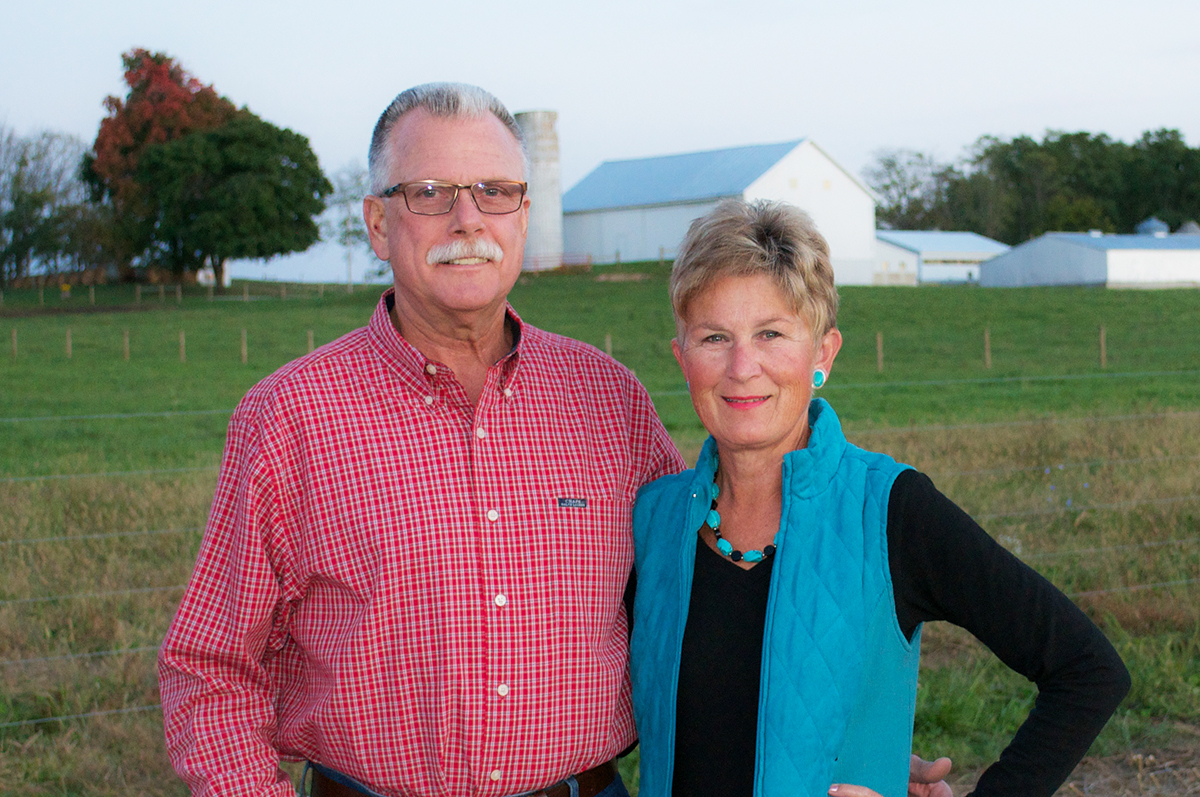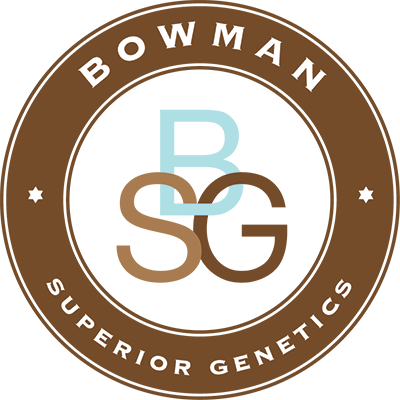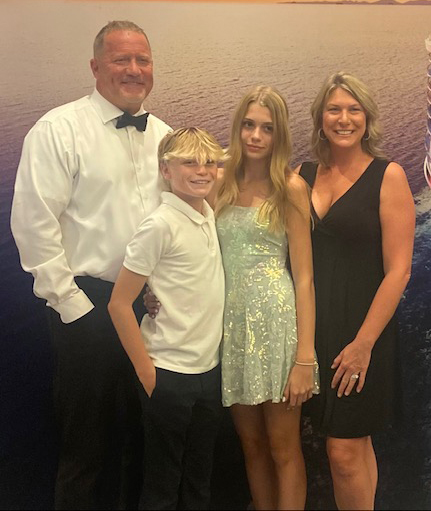Welcome to Bowman Superior Genetics.

Phil and Linda Bowman
At Bowman Superior Genetics, our story is one of family, faith, and a steadfast commitment to advancing the Shorthorn breed through science and integrity.
Established in the fall of 1994 by Phillip and Linda Bowman, our farm in Greens Fork, Indiana, began with a simple dream: to raise quality Shorthorn cattle. From the outset, we chose not to follow fleeting trends but to focus on what truly mattered at the time… first, it was nearly a decade dedicated to the kids’ junior show projects. At the turn of the century what mattered the most while the kids went away to college changed and the BSG program evolved into producing cattle with the form to function, emphasizing maternal excellence and longevity.
Our journey has been a family affair. Phil and Linda’s dedication laid the foundation, instilling in their children (Laura, Luke, and Lindsay) a deep respect for agriculture, hard work, and the importance of fact-based decisions. Their rural upbringing on the farm, surrounded by hands-on experiences and a culture of continuous learning, naturally led the kids to follow their dreams.
Today, as we continue to grow and evolve, our mission remains clear: to produce Shorthorn cattle that excel in maternal traits, adaptability, and overall profitability. We are grateful to our customers and partners who share our vision and trust in our genetics. Your success is our success, and we are honored to be part of your journey.
We invite you to visit our farm, walk through our pastures, and see firsthand the cattle and the family behind BSG. Here, you’ll find more than just superior genetics—you’ll find a legacy built on principles, passion, and a promise to always prioritize the well-being of our cattle and the prosperity of our clients.
Practical Ideas. Practical Cattle.
These two simple statements above define what goes on in this eastern Indiana Shorthorn herd; a herd that was once only a dream of mine. In an honest attempt to bring beef Shorthorns back into the mainstream marketplace for logical production, this Shorthorn herd has gone from three original cows from Wonder View Farms in 1994, to well over 100 producing females, today.
Beginning as an intense junior program while the kids were young, we were fortunate to exhibit on a national scale and receive All-American honors. However, like always, the kids grew and the show halters were hung up in the barn leading us to focus more on the cow herd than ever before. The box stalls became calving pens, and the show cattle runs became donor lots and bull facilities.

In 2019, Phillip and Linda were named Builders of the Breed by the American Shorthorn Association.
As we started traveling across the USA and Canada, we began to learn more about what production oriented Shorthorn genetics can do to the industry. We viewed this as a challenge and more importantly, a responsibility to produce exactly that: The model Shorthorn Cow. The need for maternal heterosis through a British-based breed has never been more important to the industry than it is today.
With the price of cattle these days, it is becoming much easier to cull the higher maintenance females, in turn causing cow numbers to decline. Additionally, as the next generation decides whether or not to return to the farm, it’s important to prove to them that they can be profitable with the cattle that they raise. Perhaps equally important is ensuring that they enjoy the cattle by producing docile, low maintenance breeding stock that have calving ease, fleshing ability, attractive appearance, and even aesthetic value. Everyday single day, BSG works towards these qualities.
These ideas have allowed us to develop a program utilizing superior genetics from some of the world’s best programs to generate a Shorthorn bull battery unlike any you will find- not only in Indiana, but throughout the North American continent.
What began as a dream decades ago, has transformed into a successful program that we are happy to share with you as we strive to bring you the highest quality Shorthorn breeding stock available. Stop by anytime and look over what we’re proud to offer.
We are a family operation and we’re passionately working to improve the production, promotion, and longevity of the Shorthorn breed.
What Beef Industry Leaders Have to Say...
“BSG sets the standard in the Shorthorn breed for genetic improvement. Where else can a Shorthorn enthusiast go to find more practical, real-world data? For several years Phil and his crew have gathered anything from standard performance info, to kill sheets, and ultrasound data. More recently they have incorporated the use of genomics, and composite breeding; they have essentially taken the guesswork out for any potential customers. All the while, one thing has never wavered…QUALITY! Come see for yourself where form follows function.”
“Successful breeding programs make the most of the next generation. Breeding superior genetics takes planning, disciplined selection, the use of relevant technology and time. It takes time and commitment to stack generations of cattle that excel important economically relevant traits. Bowman Superior Genetics has made this commitment and in doing so have created genetics that have relevance in all segments of the beef industry.”
“Breeding good commercially acceptable Shorthorn cattle is not easy—But BSG has done it. From the time they purchased their first Shorthorn cows from my dad, BSG has paid attention to objective data and used all the information available—and if the data wasn’t available, they measured and collected their own in order to learn more about their cows.
Phil and Luke traveled lots of miles to locate genetics to improve their cattle. They found better cattle with unique pedigrees—and so did the breed. They cattle generated by BSG over the past decades have worked in Greens Fork, IN and for their customers throughout the U.S. The cows are good—but the people are better—and the best crop Phil and Linda raised were three good kids who have a love for agriculture and the Shorthorn breed.”
“It was great to have an opportunity to go through the Bowman Superior Genetics cow herd; an impressive program! I was most impressed with the uniformity and consistency of the cattle. It wouldn’t matter what color the breed, the cows are the right kind to work in any environment and have a positive impact on the beef industry.”
“We are located in Central Florida raising both purebred and commercial cattle. I recognize the importance of sourcing outside genetics from seedstock producers that have a true understanding of the BEEF Industry. The Bowman’s were referred to me by a feedlot manager that fed their cattle multiple years and experience phenomenal results. I was very pleased to find they weren’t just breeding for feedlot performance, but also moderately framed, structurally correct, maternally oriented cattle that seem to thrive in a challenging Florida environment.”
“The Shorthorn breed as tremendous potential to contribute to the commercial beef industry. To do so, they must be objectively described genetically in large equal opportunity contemporary groups; have an abundance of convenience traits such as calving ease and shedding early and completely; and have feeder calf market desired color patterns. Unfortunately, there are too few herds producing this type of Shorthorn to meet demands. Bowman Superior Genetics is one the leading herds breeding performance-oriented Shorthorns that check all the boxes to have a very positive impact on the commercial beef industry.”
“Always promoting progress is part of the reason that Bowman Superior Genetic are known and respected not only in the US, but around the world. Newer technologies too, like 100% herd DNA enhancement, faster generational turnover to ensure greater progress are combined with the time-tested practices like collecting carcass data on every sire used and developing bulls and females on a non-starch diet in order to avoid masking non-useful genetics with feed and management, are all part of the commercial business targeted program here.
So, whether you are searching for some of the world’s most consistent and highest profit Shorthorn genetics or are considering some of the designed composite products in the future of the Bowman program, I am confident you will appreciate the commitment to customers and the commitment to the future these folks put to plan each year and for each new generation.”



